Your 3rd Week
If you ovulated and the egg
met a sperm, amazing things will happen fast. It takes just three days
from fertilization for a single egg to divide into a ball of 58 cells.
By the end of the week, this ball, called the blastocyst, will have
reached the uterus, where it will start to implant in the lining. It
will be a couple of weeks before you know whether you’ve conceived, but
special hormones kick in now to help maintain the pregnancy.
NOTE
This is the week a miracle takes place—Your baby is conceived
Fertilization
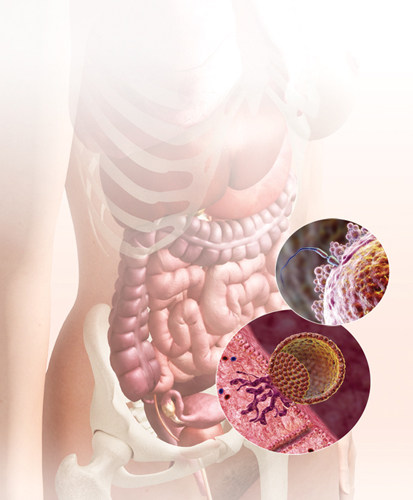
You are: 2 Weeks and 1 Day 265 days to go…
Your newly released egg will only survive 24 hours, but hopefully in that time it will meet sperm and be fertilized.
What’s happening inside
Here the egg is shown surrounded by sperm. Although only one
sperm will fertilize the egg, several hundred are thought to be
necessary to break down its defensive layers and enable fertilization to
take place.
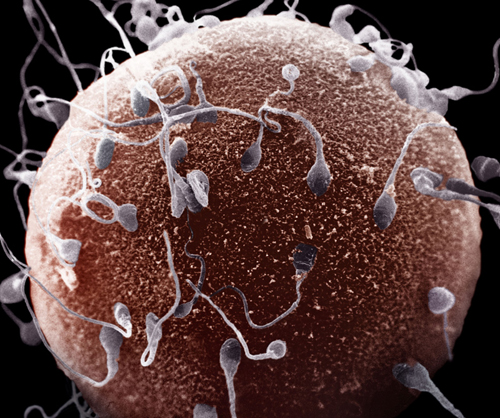
You are likely to have ovulated and your unfertilized egg now begins its journey.
Once it has been released by the ovary, the egg is swept up by one of
your fallopian tubes and, moving in the direction of the uterus, comes
to rest in the widest portion of the tube, awaiting fertilization.
It is no exaggeration to
say that for each sperm released the chance of even reaching the site of
fertilization is in the order of one in a million. Around 300 sperm
reach the tube but only one will fertilize the egg. Once the sperm has
penetrated, it triggers a reaction that makes the surface impenetrable.
Each sperm and egg contain 23 chromosomes, half of the total genetic
material required. The egg will always contain an X chromosome but the
sperm will carry either an X or Y chromosome and therefore determines
the sex of the embryo. The sperm and egg chromosomes combine forming the
“zygote” and fertilization is complete.
A few hundred sperm survive the journey and encounter the egg in the fallopian tube, but it is just one sperm that actually fertilizes the egg.
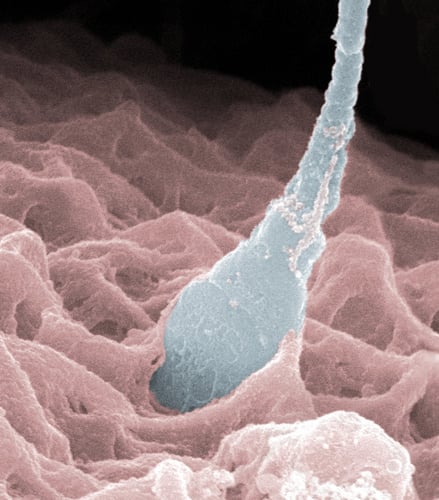
… Dads
Fit but not fertile?
If you want to become a dad,
there are many reasons why you should ensure you’re in good shape, not
least to support your partner as she prepares for pregnancy. However,
while a couch potato lifestyle isn’t desirable for men who want to
conceive, it seems that pulling out all the stops at the gym might not
be the best course of action either.
Researchers asked a
group of fit young men to exercise intensively four times a week for two
weeks. Afterward, their semen was tested and found to contain fewer
sperm and lower levels of the hormones essential for conception. These
hormonal changes were temporary and returned to near normal within a few
days of the men resuming previous levels of activity.
The concern is
that recovery might not be so fast among older men, or in those who have
poor sperm counts and/or low hormone levels. So stay in shape but don’t
overdo it.
The hormones responsible for the production of sperm are released every 60 to 90 minutes. So a man is constantly producing sperm cells.
In theory, this means
that a male is always fertile, but it takes sperm a 72-day period to
fully develop. So leading an unhealthy lifestyle during that time will
impinge on the quality. For this reason, if you’re trying to conceive,
your partner should embark on a healthy lifestyle for three months to
produce good sperm.
Genes and Inheritance
The genes that
parents pass on to their children at least partly determine their
children’s physical and mental characteristics. In some cases, an
abnormal gene may be passed on, resulting in an inherited genetic
disorder.
What are genes?
Genes are located on
rodlike structures called chromosomes that are found in the nucleus of
every cell in the body. Each gene occupies a specific position on a
chromosome. Because genes provide instructions for making proteins, and
proteins determine the structure and function of each cell in the body,
it follows that genes are responsible for all the characteristics you
inherit.
The full genetic
instructions for each person, known as the human genome, is carried by
23 pairs of chromosomes, and consists of around 20,000–25,000 genes.
How inheritance works
At conception,
the embryo receives 23 chromosomes from the mother’s egg and 23
chromosomes from the father’s sperm. These pair up to make a total of 46
chromosomes. Pairs 1 to 22 are identical or nearly identical; the 23rd
pair consist of the sex chromosomes, which are either X or Y. Each egg
and sperm contains a different combination of genes. This is because
when egg and sperm cells form, chromosomes join together and randomly
exchange genes between each other before the cell divides. This means
that, with the exception of identical twins (see How twins are conceived), each person has unique characteristics.
How gender is determined
Of the 23 pairs
of chromosomes that are inherited, one pair determines gender. This pair
is composed either of two X (female) chromosomes, in which case the
baby will be a girl, or of one X and one Y (male) chromosome, in which
case the baby will be a boy.
An egg always contains
one X chromosome, while a sperm can carry an X or a Y chromosome.
Whether your baby is a boy or a girl will therefore always be determined
by the father. If a sperm carrying an X chromosome fertilizes the egg,
the resulting embryo will be a girl. If a sperm with a Y chromosome
fertilizes the egg, the resulting embryo will be a boy. In the male,
both the X and Y chromosomes are active. In females, however one of the
two X chromosomes is deactivated early in development of the embryo in
order to prevent duplicate instructions. This could be the X chromosome
from either the mother or the father.
Gene variations
Each gene within a cell
exists in two versions, one inherited from each parent. Often these
genes are identical. However, some paired genes occur in slightly
different versions, called alleles. There may be two to several hundred
alleles of a gene, although each person can only have two. This
variation in alleles accounts for the differences between individuals,
such as color of eyes or shape of ears. One allele may be dominant and
“overpower” the other recessive one (see Dominant and recessive genes).
Why genetic disorders occur
Genes usually exist in a
healthy form, but sometimes a gene is faulty. Genetic disorders arise
either when an abnormal gene is inherited or when a gene changes, or
mutates. Genetic disorders may follow a dominant or recessive pattern of
inheritance (see Dominant and recessive genes).
They can also be passed on via the X chromosome. Such sex-linked
disorders are usually recessive, which means that a woman can carry the
faulty gene without being affected, because she has another healthy X
chromosome to compensate. If a boy receives an affected X chromosome, he
will be affected; a girl will be a healthy carrier like her mother. An
affected male could pass on the affected gene only to his daughters.
How genes are passed on
Through the generations
Through each generation, genes are shuffled and re-shuffled.
Half of a baby’s genes come from its father and half from its mother.
The baby’s parents in turn inherited half each of their genes from each
of their own parents. One quarter of each person’s genes therefore come
from the grandparents. So how does this happen? Instead of containing
the full complement of 46 chromosomes, each egg and each sperm has just
half, or 23, chromosomes each. When they meet at conception the
chromosomes pair up to again make up the full complement that now forms
the genetic blueprint for the new individual. One of the 23 pairs of
chromosomes are sex chromosomes, so gender is also determined at
conception. Each egg carries an X chromosome and each sperm either an X
or Y. If two X chromosomes combine, the baby will be a girl; if an X and
Y chromosome combine, the baby will be a boy (see How gender is determined).
Genetic inheritance means that successive generations can share certain characteristics.

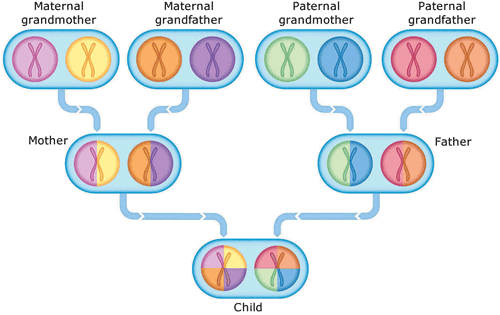
Patterns of inheritance
Dominant and recessive genes
Genes come in pairs,
and each gene in a pair may differ slightly. One gene may be dominant,
and override the other gene, which is recessive. A recessive gene only
has an effect if both genes in a pair are recessive. An example is eye
color, although this is not as simple as depicted here.
You are 2 Weeks and 2 Days 264 days to go…
When your egg has been fertilized, hormonal changes naturally occur to stop your normal menstrual cycle.
What’s happening inside
Here a human egg cell 24 hours after fertilization is
artificially colored purple. Around the egg is a thick layer (yellow)
that has now become impenetrable. The two red areas, or pro-nuclei,
contain genetic material from the mother and father before it has fused.
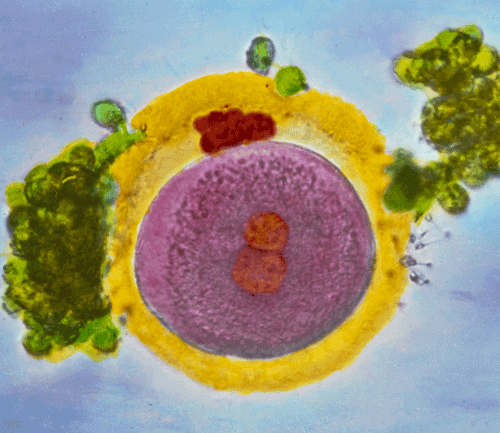
At this early stage following fertilization of your egg,
the developing embryo will signal its existence to the pituitary gland
in your brain and switch off your menstrual cycle. It does this by
producing a new hormone, called human chorionic gonadotrophin (hCG).
This hormone overrides your usual monthly cycle and maintains the high
progesterone levels that are essential for your pregnancy. The hormone
progesterone (see This is Day 4 of your Menstrual Cycle) is essential to an embryo’s survival in the uterus, and therefore to your baby’s well-being and development before birth.
Later, starting around
weeks four to five, your embryo will make all the hormones needed to
maintain its own life. Of course its nourishment and shelter come from
you, but even in the very early weeks of pregnancy the embryo behaves
like an independent human, at least as far as its hormones and genes are
concerned.
… Doctor
| Q: |
I’ve been doing ovulation tests, but they’ve all been negative. Does this mean I haven’t ovulated this month?
|
| A: |
Even if you don’t appear to have ovulated this month, you may
still have. It’s possible to miss the LH surge just by chance. This is
more likely if you don’t test at the same time each day, or you drink a
lot of water.
Remember too
that ovulation tests are imperfect, and it’s possible to get a false
negative. If you had other symptoms of ovulation, such as pain, or
changes in your mucus (see Changes during the menstrual cycle),
it’s likely that you ovulated anyway. However if you have gone two or
three months with consistently negative tests, then you might not be
ovulating regularly. In that case, it’s worth seeking medical advice.
|

Healthy conception
When you’re trying to conceive,
you’ll find you are much more aware of your general health. As a rule,
colds, flu, and other common infections are unlikely to affect your
fertility or your unborn baby if you have conceived. Some infections and
viruses, however, can have a more serious impact:
Shingles and chickenpox (both caused by the same virus) are best avoided around the time of conception if you haven’t had chickenpox before.
Food poisoning, for example caused by listeria bacteria, can be harmful .
Toxoplasmosis can be contracted from handling cat feces (see Protect yourself).
Too much testosterone can affect a woman’s fertility.
Small quantities of
testosterone are secreted from the adrenal gland and the ovaries. In low
levels it may aid fertility, but too much can affect the menstrual
cycle and lead to infertility.